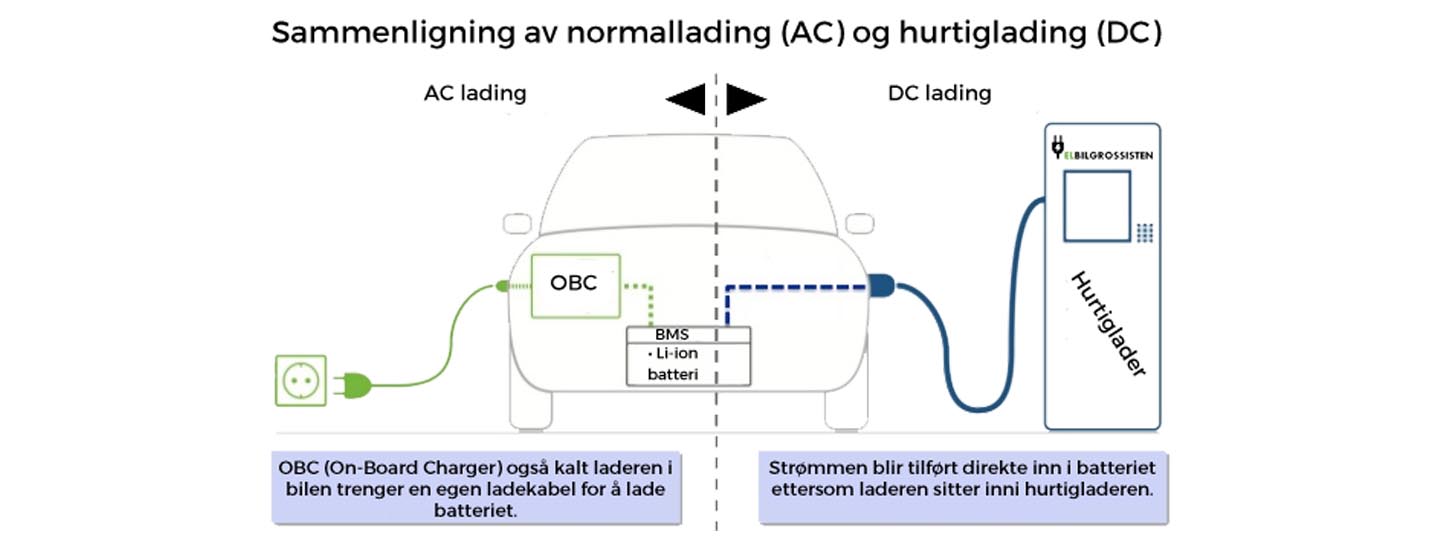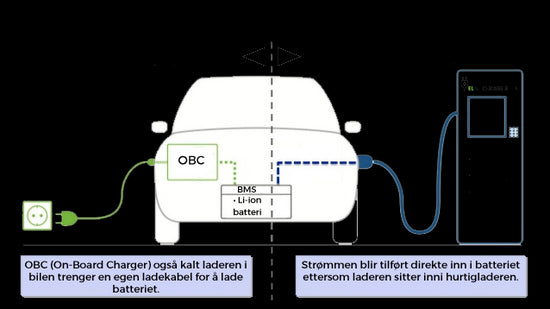Ladeguiden: Uttrykk og begreper

Contact= e.g. socket (household socket) which is on the wall or a charging socket which is on the car or e.g. on a charging station (type 2 connector)

Plug= the designation of the electrical plug or plug (eg type 2 plug) that is inserted into a socket.
What is an electric car charger?
Simply explained, electric car charging is filling up a battery with electrical energy so that it is stored there until the car needs to drive. This energy is obtained from a power source, normally from the mains. One challenge is that electrical energy has many different forms. There are different voltages and currents, and it can be alternating current or direct current. So in order to charge the battery on the electric car, the electrical energy must be transformed into the right type, and this happens in the charger. Alternating current is current that changes direction all the time (changes polarity), and it is this type of current that we have in the power grid. Alternating current is often called alternating current (AC). With direct current, the current flows in the same direction all the time, and we have a positive conductor and a negative conductor. A battery is charged via direct current and the positive conductor is connected to the positive pole of the battery, and the negative to the negative. Direct current is often called direct current (DC).
As there are different types of power on the mains and the battery, this creates some challenges. The first challenge is to convert the electrical energy from alternating current to direct current, and this is called rectifying the current (making the current direction constant). In addition to being rectified, the current and voltage must be correct so that it matches the battery. This is done in the charger that is built into the car itself (on-board charger) and the efficiency of this determines how quickly the car can charge with alternating current. The size of the charger built into the car varies. The smallest is 3.3kW and the largest is 43kW. Today's on-board chargers are usually between 3.3kW and 22kW.
What is the difference between normal charging and fast charging?
Many people refer to the charging cable as the "charger", but the charger is actually in the car and it is the charging cable that supplies it with electricity. The picture summarizes the main differences between normal charging and fast charging. Feel free to read more about fast charging in our charging guide.


Electric Vehicle Supply Equipment (EVSE)
EVSE is a collective term for all products/equipment that ensure the safe charging of plug-in hybrids and electric cars. This includes charging cables, charging stations/posts and similar equipment. The equipment consists of a combination of software and hardware in the charging solution, and increases safety by establishing a two-way communication between the equipment and the electric vehicle. This two-way communication ensures that the current supplied to the vehicle is both below the limit value for the equipment, as well as below the limits of what the car can receive. For example, one of the security functions is called "lock-out". This feature means that the equipment will not supply power through the cable until the connector is physically connected in the car.
Portable EVSE cables
An electric car is usually delivered with a charging cable where the EVSE has been built into a box (In Cable Control Box / ICCB), often referred to as the "clunk" on the cable. This is for security reasons and the various security levels, or also called charging mode. You can read more about the charging mode here.

Energy (kwh)
The battery capacity in the car is measured in kWh, which stands for kilowatt-hours (kWt is often used in Norwegian). A 30kWh battery can supply 30kW for one hour, or 15kW for two hours. This is how much energy is stored in the battery (almost the same as the number of liters of petrol in a petrol tank). Therefore, kWh is also used to indicate how much energy you have received from a fast charging station, for example that you received 17.3 kWh during a charge. The electricity bill at home is also specified in kWh, and the price is usually just under one kroner for each kWh. Most modern electric cars in Norway have a battery capacity of between 20 and 60 kWh, while Tesla models have a gross capacity of up to 100 kWh.
Current (amps)
The unit of measurement for electric current is the ampere, which is often abbreviated (A). Electric current - or simply current - is the electrons that flow through the conductor we are thinking of. An analogy could be current in a water pipe, where the water droplets flow through. The more water droplets that flow through, the stronger/more current. Similarly, the more electrons that flow, the more current flows in the wire.
Voltage (volt)
The unit of measurement for electrical voltage is the volt and is often abbreviated (V). Electric voltage says something about the force with which the electrons are being pushed. Here, too, we can compare it to water in a pipe system. If the water pressure is low, there is little power in the water jet. In contrast, a high-pressure washer will spray out the water with great force, and therefore the voltage in a circuit can resemble the pressure in a water hose.
Power (Watt)
The unit of measurement for power is the watt and is abbreviated as (W). Watts are measured in transmitted current per unit of time and electrical power is how quickly we use electrical energy. Power is the sum of current and voltage and can be compared to the amount of current multiplied by the voltage. Continuing the garden hose analogy, we can say that watts are how much water comes out of the hose per unit of time. If something uses a lot of energy, it may be easier to use terminologies such as kilowatts (kW) instead of Watts. Kilowatt means one thousand Watts: 1kW = 1000W. Kilowatt then expresses the effect which is a function of multiplying voltage (V) by current (A) by the number of phases (in three-phase it is multiplied by the square root of 3).
Battery and charging time
Batteries are stated in the number of kWh (kilowatt hours) and this refers to the car's total battery capacity. By taking the car's available battery capacity (kWh) and dividing by the stated charging power (kW), you find the theoretical time it takes to charge the car (0-100%).
If a charger is connected to a normal socket that provides a voltage of 230V and produces a maximum of 10A, this charger will produce an output of 2300W (2.3kW) (V * A = W). This means that the charger provides 2.3 kW per hour. For example, a Nissan LEAF (2013 model) has a battery capacity of 24 kWh and will thus be fully charged in 10-11 hours (24 kWh / 2.3 kW = 10.4 hours). This is the theoretical calculation and there are several factors that have an impact on the charging speed, including temperature.
Hard to find the right equipment for your car?
The charging cables for electric cars and plug-in hybrids are mainly supplied with mode 2 (portable) and mode 3 (fixed) charging and have either a type 1 or type 2 connector on the car. If you are not sure which charging cable or which product is suitable for your car, you can use our charging guide, chat with us on the right, or contact us at kundeservice@elbilgrossisten.no and we will help you find the right product.

